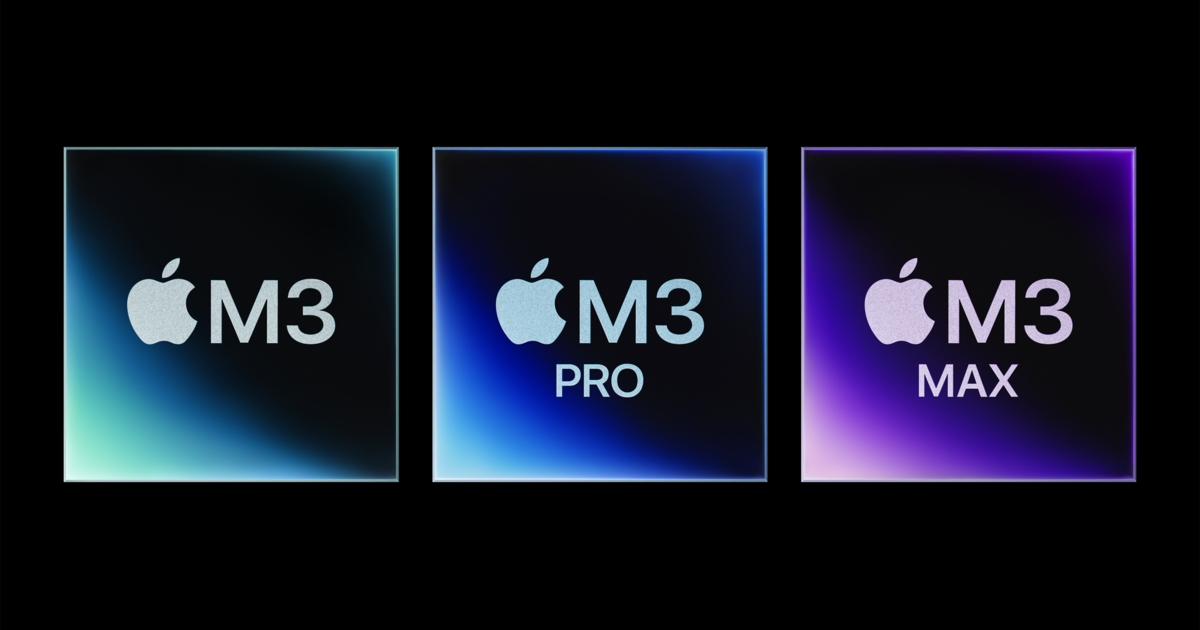Apple Silicon M3 is the name logically chosen by Apple to succeed the Apple Silicon M2. The new SoC which will equip all Macs should allow the Apple firm to maintain its leadership in terms of energy efficiency. Qualcomm and Intel have already put forward their strengths, the Snapdragon X Elite and Meteor Lake respectively. If Meteor Lake processors are expected in December, we will have to wait until mid-2024 to see the arrival of the first laptops powered by a Snapdragon.
With its M3, Apple pulls the rug out from under its competitors and confirms its lead in terms of efficiency. Especially since the first products featuring this first chip engraved in 3 nm will be available in the days to come.
3 nm and up to 97 billion transistors
The new engraving fineness of 3 nm allows the Apple brand to increase the frequency of these chips while maintaining formidable energy efficiency. Thus the CPU cores are announced as being 40% more efficient for the P cores and 50% for the E cores of the first iteration of the Apple M. On the other hand, we must count on a generational gain of 15 and 30% respectively. . According to Apple, the M3 uses half as much energy as the M1 at an equivalent performance level, compared to an Intel Core i7 with 12 cores (probably the Core i7-1360p). The M3 would only consume a quarter of the energy of its competitor for the same level of performance.
The Neural Engine also benefits from fine engraving since it is 15% more efficient than its predecessor. This part of the processor is used for local AI processing and in particular during automatic clipping.
More efficient GPU cores for gaming
However, it is on the GPU core side that the new developments are happening. The M3s are entering the game a little further by now supporting Mesh Shading and Ray-tracing, a first. To summarize, the lighting effects are much more detailed and realistic thanks to Ray-Tracing and Mesh Shading allows you to increase the in-game frame rate (per second).
Added to this is the Dynamic Caching option introduced on the M3 which allows the amount of memory necessary to the GPU to be automatically allocated in real time. In fact, on the Apple M architecture, the memory is of the unified type, the CPU and GPU cores draw from the same memory envelope. From now on, this envelope will be dynamically shared between CPU cores and GPUs to always have the right amount of memory allocated based on demand.
According to Apple, the gains in terms of GPU cores are therefore significant since the GPU cores of the M3 would be 1.8x more efficient compared to the M2 and 2.5x more efficient than those of the M1. Enough to make Macs real gaming machines thanks to the power of the M3’s GPU cores.
Three variations of the M3 to start
As usual, Apple will offer three variants of its Apple Silicon M. The first variant, simply called M3, has 25 billion transistors, or 5 more than the M2 with 8 CPU cores distributed equally between Performance cores and Efficient cores. 10 GPU cores and a maximum of 24 GB of unified memory complete this M3 which therefore retains exactly the same architecture as the M2. Initially, the M3 will find its place in the iMac 24 2023 and the MacBook Pro 14 2023.
The second variant retains the previous nomenclature and is logically called M2 Pro. Unlike the M2 Pro, the M3 Pro distributes its 12 CPU cores evenly with 6 Efficient cores and 6 Efficient cores which are associated with 18 GPU cores, one less than the M2 pro. Finally, the amount of unified memory increases from 32 to 36 GB. The M3 Pro will find its place in the MacBook Pro 14 and 16.
The third variant is therefore logically the M3 Max. Unlike previous years where the M2 Max was only a version with more GPU cores, the M3 Max differentiates itself with 16 CPU cores, 12 of which are Performance cores. The number of GPU cores thus increases from 38 to 40 and the amount of unified memory to 128 GB compared to 96 for the M2 Max. The M3 Max will only be available in the MacBook Pro 16.
In terms of pure performance, generational gains vary depending on the variations. Thus the M3 would be 40% more efficient than the M2, the M2 Pro “only” 20% more efficient than its predecessor while the M3 Max promises to be twice as efficient as its M2 equivalent.
Don’t let Intel and Qualcomm come back
Apple is once again reviewing its M architecture with significant generational gains and welcome GPU developments. It must be said that the competition (Qualcomm and Intel) intends to catch up with new architectures. The year 2024 promises to be particularly attractive in the closed world of processors.
We will obviously not fail to test the developments of the Apple Silicon M3 in the coming weeks when we get our hands on the new MacBook Pro and iMac.
